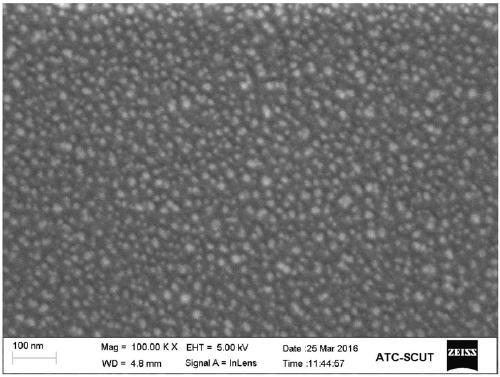A kind of waterborne polyurethane anti-glare coating material and preparation method thereof
A technology of water-based polyurethane and coating materials, applied in the direction of polyurea/polyurethane coatings, coatings, etc., can solve the problems of complex preparation process and industrialization to be improved, and achieve uniform distribution, increased dispersion and storage stability, and durability The effect of reducing polishability
- Summary
- Abstract
- Description
- Claims
- Application Information
AI Technical Summary
Problems solved by technology
Method used
Image
Examples
Embodiment 1
[0042](1) Put 94.08g of polytetrahydrofuran diol (PTMG-1000, 1000g / mol) and 3.90g of 2,2-dimethylolpropionic acid after dehydration into the reaction kettle at room temperature, drop 0.05g of dihydrofuran Dibutyltin laurate catalyst, after stirring evenly, add 52.02g of isophorone diisocyanate (control R value 1.9:1) for prepolymerization reaction: first gradually raise the temperature to 60°C, react for 1.5h; then continue to heat up to 80°C , Reaction 2.5h. During the reaction, the remaining NCO group content was determined to be constant by di-n-butylamine method. The prepolymer was cooled to about 40°C.
[0043] (2) Add 2.94 g of triethylamine to the product obtained in step (1), neutralize to form a salt for 10 minutes, and further cool to 30° C.
[0044] (3) Pour the product of step (2) into 409.00 g of sodium ethylenediamine ethyl sulfonate aqueous solution with a mass concentration of 2.73%, emulsify and extend the chain for 15 minutes, and the stirring rate is 3000 ...
Embodiment 2
[0054] (1) Put 87.32g of PTMG-1000 and 5.34g of 2,2-dimethylolbutanoic acid after dehydration treatment in the reaction kettle at room temperature, drop in 0.15g of dibutyltin dilaurate catalyst, stir well, add 52.02g of isophorone diisocyanate (control R value 1.9:1) for prepolymerization: first gradually raise the temperature to 65°C, react for 1.0h; then continue to raise the temperature to 82°C, react for 2.0h. During the reaction, the remaining NCO group content was determined to be constant by di-n-butylamine method. The prepolymer was cooled to about 50°C.
[0055] (2) Add 4.17 g of tripropylamine to the product of step (1), neutralize to form a salt for 15 minutes, and further cool to 25°C.
[0056] (3) Pour the product of step (2) into 222.50 g of sodium ethylenediaminoethylsulfonate aqueous solution with a mass concentration of 7.00%, emulsify and extend the chain for 20 minutes, and the stirring rate is 1800 rpm.
[0057] (4) At a stirring rate of 1000 rpm, 2.19 g...
Embodiment 3
[0060] (1) Put 102.24g of PTMG-1000 and 3.90g of 2,2-dimethylolpropionic acid after dehydration treatment in the reaction kettle at room temperature, drop in 0.09g of bismuth isooctanoate catalyst, stir well, add 43.86g Prepolymerization of isophorone diisocyanate (control R value 1.5:1): first gradually raise the temperature to 55°C, react for 1.5h; then continue to raise the temperature to 80°C, react for 2.5h. During the reaction, the remaining NCO group content was determined to be constant by di-n-butylamine method. The prepolymer was cooled to about 40°C.
[0061] (2) Add 1.02 g of ammonia water to the product of step (1), neutralize to form a salt for 10 minutes, and further cool to 30°C.
[0062] (3) Pour the product of step (2) into 504.00 g of sodium ethylenediamine ethylsulfonate aqueous solution with a mass concentration of 0.50%, emulsify and extend the chain for 15 minutes, and the stirring rate is 3000 rpm.
[0063] (4) At a stirring rate of 800 rpm, 6.63 g of...
PUM
| Property | Measurement | Unit |
|---|---|---|
| particle size | aaaaa | aaaaa |
| particle size | aaaaa | aaaaa |
| particle diameter | aaaaa | aaaaa |
Abstract
Description
Claims
Application Information
 Login to View More
Login to View More - R&D
- Intellectual Property
- Life Sciences
- Materials
- Tech Scout
- Unparalleled Data Quality
- Higher Quality Content
- 60% Fewer Hallucinations
Browse by: Latest US Patents, China's latest patents, Technical Efficacy Thesaurus, Application Domain, Technology Topic, Popular Technical Reports.
© 2025 PatSnap. All rights reserved.Legal|Privacy policy|Modern Slavery Act Transparency Statement|Sitemap|About US| Contact US: help@patsnap.com

